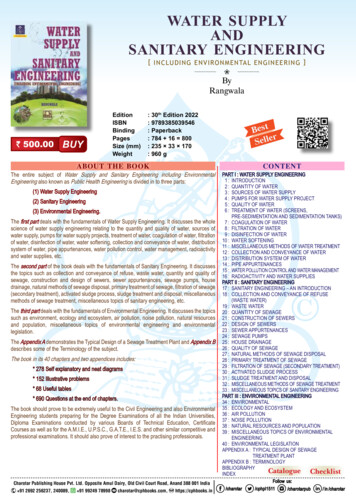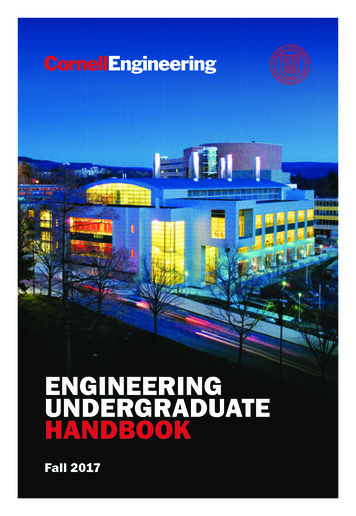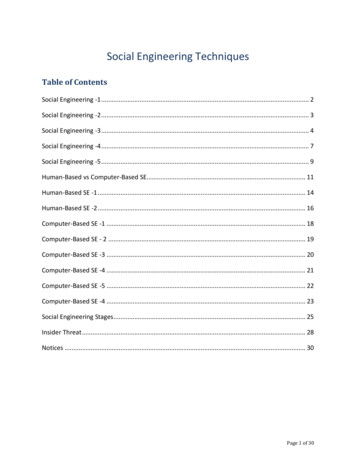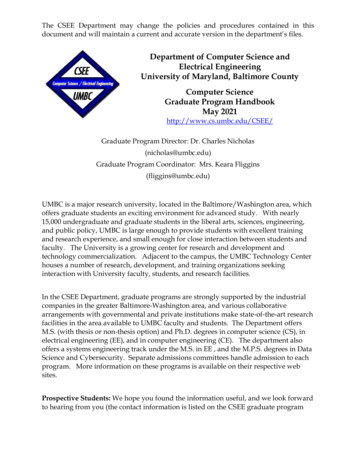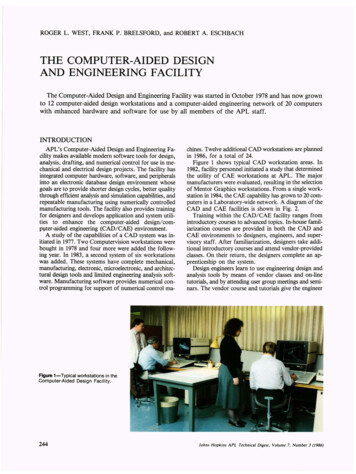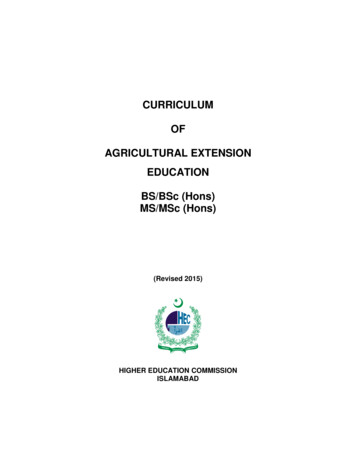
Transcription
CURRICULUMOFAGRICULTURAL EXTENSIONEDUCATIONBS/BSc (Hons)MS/MSc (Hons)(Revised 2015)HIGHER EDUCATION COMMISSIONISLAMABAD
CURRICULUM DIVISION, HECProf. Dr. Mukhtar AhmedMr. Fida HussainMs. Ghayur FatimaMr. Rizwan ShoukatMr. Abid WahabMr. Riaz-ul-HaqueChairmanDirector General (Acad)Director (Curriculum)Deputy Director (Curr)Assistant Director (Curr)Assistant Director (Curr)2
Composed by: Mr. Tanveer Ali, HEC3
0ONTENTS1.Introduction62.Template for 4-Year BS/BSc. (Hons)in agricultural disciplines83.Scheme of studies for undergraduate courses inagricultural extension education104.Details of courses for undergraduate studies inagricultural extension education115.Semester wise break-up296.Scheme of studies for post-graduate coursesin agricultural extension307.Detail of courses for post-graduate studies inagricultural extension318.Annexure A - G479.Recommendations714
PREFACEThe curriculum, with varying definitions, is a plan of the teaching-learningprocess that students of an academic programme are required to undergo.It includes objectives and learning outcomes, course contents, scheme ofstudies, teaching methodologies and methods of assessment of learning.Knowledge in all academic disciplines is expanding and even newdisciplines are also emerging, it is imperative that curriculum aredeveloped and revised regularly.University Grants Commission (UGC) was designated as the competentauthority to develop, review and revise curricula beyond Class-XII videSection 3, Sub-Section 2 (ii), Act of Parliament No. X of 1976 titled“Supervision of Curricula and Textbooks and Maintenance ofStandard of Education”. With the repeal of UGC Act, the same functionwas assigned to the Higher Education Commission (HEC) under itsOrdinance of 2002, Section 10, Sub-Section 1 (v).In compliance with the provisions, the Curriculum Division of HECundertakes the revision of curricula after every three years throughrespective National Curriculum Revision Committees (NCRCs) whichconsist of eminent professors and researchers of relevant fields frompublic and private sector universities, R&D organizations, councils,industry and civil society nominated by their organizations.In order to impart education at par with quality international standards,HEC NCRCs have developed unified templates as guidelines for thedevelopment and revision of curricula in the disciplines of Basic Sciences,Applied Sciences, Social Sciences, Agriculture and Engineering in 2007and 2009.It is hoped that this curriculum document, prepared by the respectiveNCRC’s, would serve the purpose of meeting our national, social andeconomic needs, and it would also provide the level of competencyspecified in Pakistan Qualification Framework to make it compatible withinternational educational standards. The curriculum is also placed on thewebsite of HEC (www.hec.gov.pk).(Fida Hussain)Director General (Academics)5
CURRICULUM DEVELOPMENT PROCESSSTAGE-ISTAGE-IISTAGE-IIICURRI. UNDERCONSIDERATIONCURRI. INDRAFT STAGEFINAL STAGECOLLECTION OFRECAPPRAISAL OF 1STDRAFT BY EXP. OFCOL./UNIVPREP. OF FINALCURRI.QUESTIONNAIRECONS. OF CRC.FINALIZATION OFDRAFT BY CRCINCORPORATION OFREC. OF V.C.C.COMMENTSPREP. OF DRAFTBY CRCAPPROVAL OFCURRI. BY V.C.C.PRINTING OFCURRI.REVIEWIMPLE. OF CURRI.BACK TO STAGE-IAbbreviations Used:CRC.Curriculum Revision CommitteeVCC.Vice Chancellor’s S6STAGE-IVFOLLOW UPSTUDY
CURRICULUM DEVELOPMENTThe final meeting of National Curriculum Revision Committee (NCRC) washeld at University of Agriculture, Faisalabad from April 28-30, 2015 tofinalize the 2nd draft of Agricultural Extension Education curriculum. Thefollowing experts attended the meeting:Prof. Dr. Sher MuhammadInstitute of Agricultural Extension and RuralDevelopment,University of Agriculture, FaisalabadConvenerProf. Dr. Munir AhmadInstitute of Agricultural Extension and RuralDevelopment, University of Agriculture,FaisalabadMemberProf. Mr. Amjad AliChairman,Department of Agricultural Extension,Baluchistan Agriculture College, Chaman Road,Baleli, QuettaMemberProf. Dr. Ejaz Ahmad KhanChairman,Department of Agronomy/Botany,Gomal University, Dera Ismail KhanMemberProf. Dr. Khalid NawabChairman,Department of Agricultural Extension, Education& Communication,The University of Agriculture, PeshawarMemberProf. Dr. Muzammil Hussain SiddiquiChairman,Department of Agronomy, Faculty of Agriculture,University of Poonch, Rawalakot, AJKMemberDr. Muhammad Riaz ChatthaDirector/Coordinator,Department of Agri. Extension,Agriculture Poly-technique Institute,National Agricultural Research Center (NARC),Park Road, Chak Shehzad, IslamabadMember7
Dr. Zaheer Uddin MiraniAssociate Professor,Agricultural Extension EducationSind Agriculture University, Tando JamMemberDr. Farhat Ullah KhanAssistant Professor,Department of Agricultural Sciences,Allama Iqbal Open University, IslamabadMemberDr. Muhammad LuqmanAssistant Professor,University College of Agriculture,University of Sargodha, SargodhaMemberDr. Muhammad WaseemAssistant Professor,Faculty of Agriculture,Lasbela University of Agriculture, Water &Marine Sciences, Uthal, Lasbela, BalochistanMemberDr. Sajid AliAssistant Professor,Institute of Agricultural Sciences,Quaid-e-Azam Campus,University of the Punjab, LahoreMemberMr. Muhammad Hamid Nawaz KhanLecturer,Department of Agricultural Extension Education,University College of Agriculture &Environmental Sciences,Islamia University of Bahawalpur, BahawalpurMemberDr. Badar Naseem SiddiquiAssociate Professor & Chairman,Department of Agricultural ExtensionFaculty of Crop and Food Sciences,PMAS-Arid Agriculture University Rawalpindi8Member/Secretary
Template for 4-Year BSc (Hons) in AgriculturalDisciplines1.Compulsory CoursesMathematics/Biology (2 courses)Statistics 1 & 2Computer/ITPakistan StudiesIslamic StudiesCommunication SkillsEnglishBasic AgricultureSub-Total2.Interdisciplinary Foundation CoursesAgronomyPlant Breeding & GeneticsEntomologyPlant PathologyFood TechnologyHorticultureSoil ScienceAgriculture EconomicsSub-Total3.Supporting Courses {6-8 courses (3 Cr. hr)amongst below}Agriculture ExtensionForestry & Range ManagementAnimal ScienceMarketing & Agri. BusinessRural DevelopmentHuman NutritionAgriculture ChemistryAgriculture EngineeringWater ManagementAny other discipline recommended by the universitySub-TotalSub-Total during the first four semestersSemester 5, 6, 7 & 8Project/InternshipGrand Total9Credit hours6 (3-0) (2-1)6 (3-0) (3-0)3 (2-1)2 (2-0)2 (2-0)3 (3-0)3 (3-0)3 (2-1)28(3 Cr. hr)2418-2470-7656-6004130-140
1 credit of Theory one contact hour per week for 16-18 weeks and 1Practical/Lab hour 3 contact hours per week for 16-18 weeks.In case of non-availability of department of supporting courses, coursesfrom foundation courses can be opted.10
SCHEME OF STUDIES FOR UNDERGRADUATECOURSES IN AGRICULTURAL EXTENSION EDUCATIONAEE 301Introduction to Agricultural Extension3(2-1)AEE 402Introduction to Communication in Agricultural3(2-1)ExtensionAEE 501Communication and Leadership Skills in3(2-1)Agricultural ExtensionAEE 502Agricultural Journalism3(2-1)AEE 503Introduction to Extension Education Methods3(2-1)AEE 504Adult Learning3(3-0)AEE 505History and Philosophy of Agricultural Extension3(3-0)AEE 506Extension Programme Development3(2-1)AEE 507Rural Development Programmes in Pakistan3(3-0)AEE 508Rural Youth in Agricultural Development3(2-1)AEE 509Agricultural Technology Transfer3(2-1)AEE 510Poverty Alleviation and Sustainable Development3(3-0)AEE 601Introduction to Cyber Extension3(2-1)AEE 602Introduction to Programme Evaluation3(2-1)AEE 603Human Resource Development3(2-1)AEE 604Research Methods in Social Sciences3(2-1)AEE 605Agricultural Advertising3(2-1)AEE 606Biodiversity and Agricultural Extension3(3-0)AEE 607Agricultural Extension and Gender Studies3(3-0)AEE 608Distance Education2(1-1)AEE 609Food Security and Agricultural Extension3(3-0)AEE 610Internship4(0-4)11
DETAIL OF COURSES FORUNDERGRADUATE STUDIES INAGRICULTURAL EXTENSION EDUCATIONAEE 301INTRODUCTION TO AGRICULTURALEXTENSION3(2-1)Course ObjectivesAt the completion of this course, the students will be able to: Comprehend the concept and principles of effective extension Identify the organizational set-up of agricultural extension Understand the concept of adoption/diffusion of innovations,motivation, planning and evaluationAgricultural extension; its definition, objectives and importance. Types ofeducation. Brief history/recent trends in agricultural extension.Organizational set-up of agricultural extension at provincial level. Role ofprivate sector in agricultural development. Characteristics of Pakistanifarmers, farming problems and solutions thereof. Roles and duties ofextension workers at various organizational levels. Principles of effectiveextension work. Adoption and diffusion of agricultural innovations.Motivation techniques. Laws of adult learning. Role of rural youth andwomen in agricultural development. Extension, research and farmerslinkages.PracticalIdentification of farming problems, their prioritization and possiblesolutions thereof. Preparation of audio-visual material.Recommended Books1.Memon, R. A. and E. Bashir. (Eds.) 1997. Extension Methods (2 nded.). National Book Foundation, Islamabad.2.Nisha, M. 2006. Understanding Extension Education. GyanPublishing House, India.3.Ray, G. L. 2006. Extension Communication and Management.Kalyani Publishers, India.4.Singh, D. 2012. Agricultural Extension and Rural Development,Kalyani Publishers, India.12
AEE 402INTRODUCTION TO COMMUNICATION INAGRICULTURAL EXTENSION3(2-1)Course ObjectivesAt the completion of this course, the students will be able to: Comprehend the concept, process and scope of communication Analyse different forms and models of communication Identify different barriers to communicationTheoryConcept, purpose and scope of communication in agricultural extension.Communication process, elements and their role in effectivecommunication. Principles of communication. Basic communicationmodels. Forms of communication: interpersonal, intrapersonal andimpersonal. Barriers to communication and measures to overcome thesebarriers.PracticalThe students will be involved in developing and critically analysingdifferent extension messages. They will practice different forms ofcommunication in the class.Recommended Books1.2.3.4.Memon, R. A. and E. Bashir (Eds.), 1995. Extension Methods.National Book Foundation, Islamabad.Rosengren, K. E. 2000. Communication: An Introduction. SagePublication, London, UK.Shahid, M. I. 1996. Communication. Caravan Enterprises, Lahore,Pakistan.Muhammad, S. 2005. Communication and LeadershipDevelopment. Unitech Communications, Faisalabad.AEE 501COMMUNICATION AND LEADERSHIP SKILLSIN AGRICULTURAL EXTENSION3(2-1)Course ObjectivesAt the completion of this course, the students will be able to: Comprehend various types of communication Demonstrate improved communication/leadership skillsTheoryTypes of communication i.e. written, verbal, and non-verbal.Communication skills: Speaking, listening, writing and reading. Speaking13
face-to-face communication. Preparing and delivering a speech.Conducting discussions and interviews. Conducting extension meetings.Improving facilitation skills. Listening---Reasons for poor listening. Tips forimproving listening skills. Writing---Art of good writing. Writing fornewspapers and magazines. Writing letters, reports and articles frequentlyrequired for the job of an extension worker. Reading---- Reasons for poorreading. Tips for developing effective reading skills. Use of audio-visualaids. Presentation skills. Leadership: concept, functions, styles and types.Roles and characteristics of leadership.PracticalMicro-teaching---Students will plan and practice extension teaching insmall groups. They will also maintain a practical notebook regardingpreparation of instructional designs.Interviewing ---Students will interview farmers and extension workers toidentify their problems. Writing Skills---Students will prepare variousregisters including stock register, store book, etc. and will prepare differenttypes of reports required for the job of extension worker includingmaintenance of office records.Recommended Books1.Calvert, P. (Ed.) 2000. The Communicator's Handbook: Tools,Techniques and Technology (4th ed.). Maupin House ionEducationCommunication in Agriculture, RBS College, Bichpuri, Agra, India.3.Muhammad, S. 2005. Communication Skills & LeadershipDevelopment. Unitech Communications, Faisalabad.4.Kalla, P. N. 2006. Communication Skills for Extension Workers.Agrotech Publishing Academy, Udaipur, India.5.Ray, G. L. 2006. Extension Communication and Management.Kalyani Publishers, India.6.Shriberg, B., R. Kumari, and A. Shirberg. 2011. PracticingLeadership: Principles and Applications. (3rd ed.). John Wiley, NewYork, USA.AEE 502AGRICULTURAL JOURNALISMCourse ObjectivesAt the completion of this course, the students will be able to: Understand the concept of agricultural journalism Develop news, news stories, and articles Critically analyse various news stories and articles143(2-1)
TheoryJournalism: definition, types, importance, and history. Developmentjournalism: concept, scope, significance, roles, and functions. Applicationof journalism in agricultural extension. Fundamental elements of print andbroadcast journalism. News editing and its significance. Preparation andreporting news for media. Column writing. Laws and code of ethics for theagricultural professional journalists involved in publishing. Review of someimportant world newspapers publishing agricultural news stories, articles,and related information. Introduction to e-journalism. Exposure toimportant agricultural news channels, websites, radio, and TV.PracticalThe student(s) will prepare and report agricultural information in the formof news, news stories, news articles, and/or documentaries.Recommended Books1.Boone, K., T. Meisenbach, and M. Tucker. 2003. AgriculturalCommunications: Changes and Challenges. John Wiley-BlackwellPublishers, London.2.Haq, M. Z. 2015. A Book on Agricultural Journalism: aka,Bangladesh.3.Harcup, T. 2009. Journalism: Principles and Practices. SagePublishers.4.Vivian, J. 2000. Media of Mass Communication (5 th ed.). Allyn andBacon, London.AEE 503INTRODUCTION TO EXTENSION EDUCATIONMETHODS3(2-1)Course ObjectivesAt the completion of this course, the students will be able to: Develop an instructional plan Understand the teaching-learning process Select and apply various extension methods under differentsituationsTheoryTeaching as a process of facilitating learning, developing an instructionalplan for extension teaching. Classification of extension teaching methods:individual, group and mass contact methods. Merits and demerits ofvarious extension methods. Critical analysis of various extensionmethods. Planning, conducting and follow up of various extensionmethods.15
PracticalEach student will develop an instructional plan for a given extensionteaching situation. The student(s) will be involved in micro teaching/fieldsituation concerning agricultural extension.Recommended Books1.Anandajayasekeram, P. et al. 2008. Concepts and Practices inAgricultural Extension in Developing Countries: A Source Book.IFPRI, Washington DC, USA.2.Memon, R. A. and E. Bashir. (Ed.). 1997. Extension Methods (2 nded.). National Book Foundation, Islamabad.3.Muhammad, S. 2005. Communication and LeadershipDevelopment. Unitech Communications, Faisalabad.4.Ray, G. L. 2006. Extension Communication and Management.Kalyani Publishers, India.5.Saravanan, R. (Ed.). 2008. Agricultural Extension-WorldwideInnovations. New India Publishing Agency, India.6.Van den, Ban, A. W. and H.S. Hawkins, 1996. AgriculturalExtension. (2nd ed.). John Wiley Blackwell, USA.AEE 504ADULT LEARNING3(3-0)Course ObjectivesAt the completion of this course, the students will be able to: Differentiate between active and passive learners Demonstrate the working knowledge of learning theories Evaluate the learners’ achievementsApplication of educational psychology in agricultural extension. Domainsof learning: cognitive, affective and psychomotor. Levels of learning.Comparative analysis of active learners with passive learners. Bloom’staxonomy of adult learning. Farmers as adult learners; implications ofphysical, mental, emotional and social aspects for learning; personalitytypes and their effect on learning and human relationship. Informationprocessing models. Sensory input. Pattern recognition and varioustheories of pattern recognition. Theories of attention and motivation.Problems of adjustment and understanding human behaviour according tothe changed conditions. Handling farmers/learners, problem-solving anddecision- making strategies. Evaluation of learners’ achievements.Recommended Books1.Reeve, J. M. 2014. Understanding, Motivations and Emotions (6thed.). John Wiley & Sons Inc., USA.2.Woolfolk, A. E. 2012. Educational Psychology. 12th ed. Amazon16
3.4.Publishers, Singapore.Tennant, M. 2005. Psychology and Adult Learning. RoutledgePublishers, UK.HEC. (nd). Teaching Learning Material for Training of Teachers ofHigher Education. Module-1, Educational Psychology. Islamabad,Pakistan.AEE 505HISTORY AND PHILOSOPHY OFAGRICULTURAL EXTENSION3(3-0)Course ObjectivesAt the completion of this course, the students will be able to: Explain the philosophical roots of agricultural extension education Describe the historical perspective of agricultural extension Analyse Islamic philosophy of extension educationEvolution of agricultural extension worldwide. Historical perspective ofagricultural extension education in Pakistan. Past performance of variousextension approaches. Emergence of private sector extension in Pakistanincluding input manufacturing and supply agencies, commercial banks,and NGOs. Philosophy and its branches. Philosophical foundations ofagricultural extension education. Islamic bases and foundations ofagricultural enterprises. Islamic philosophy of extension education.Recommended Books1.Anandajayasekeram, P., R. Puskur, S. Workneh and D. Hoekstra.2008. Concepts and Practices in Agricultural Extension inDeveloping Countries: A Source Book. IFPRI, Washington DC,USA.2.Cahn, S. M. (Ed.) 2009. Philosophy of Education: The EssentialTexts. Routledge Publisher, UK.3.Lewis, D. and N. Kanji. 2009. Non-Governmental Organizations andDevelopment. Abingdon, Routledge Publisher, UK.AEE 506EXTENSION PROGRAMME DEVELOPMENT3(2-1)Course ObjectivesAt the completion of this course, the students will be able to: Understand the concept of programme development and PCs Describe principles of effective programme development Analyse various programme development models Plan an extension programme17
TheoryProgramme development: purpose, concept, scope, significance,assumptions, characteristics, and principles. Programme developmentapproaches and models. Steps in programme development: situationanalysis, needs assessment, statement of objectives, preparing plan ofwork, implementing work plan, monitoring and evaluation. An overview ofthe PCs (Planning Commission Proformae).PracticalThe students will conduct situational analysis and needs assessment.They will plan extension programs based on prioritized needs of extensionclientele. They will also submit a PC-1 on the given programme/project.Recommended Books1.Bennett, C. and K. Rockwell, 1995. Targeting Outcomes ofPrograms. A Hierarchy for Targeting Outcomes and Evaluating theirAchievement. Discovery Publishing House, New Delhi, India.2.Boyles, 1984. Planning Better Programmes. McGraw Hill. NewYork, USA.3.Caffarella, R. S. 2001. Planning Programs for Adult Learners. APractical Guide for Educators, Trainers, and Staff Developers. (2 nded.). Jossey Bass Publishers, USA.4.Gupta, D. D. 2008. Extension Education: Core Contents andEmerging Area. Agribios. Jodhpur, India.5.Ray, G. L. 2006. Extension Communication and Management.Kalyani Publishers, India.AEE 507RURAL DEVELOPMENT PROGRAMMES INPAKISTAN3(3-0)Course ObjectivesAt the completion of this course, the students will be able to: Comprehend philosophy of rural development programmes Identify various rural development programmes Critically analyse government plans and policies related to ruraldevelopmentConcept, philosophy, importance and objectives of rural development.Main approaches/programmes of rural development in Pakistan i.e. VAID, Basic Democracies, Rural Works Programme, IRDP, Social ActionProgramme, People Works Programme, Tameer-e-Watan Programme,Khushhal Pakistan Programme, Village Cooperatives, Supervised CreditScheme, participatory rural development projects, community basedorganizations. Current rural development programs: rural support and18
rural development programs of NGOs, National Programme forImprovement of Water Courses, National Programme of Integrated PestManagement, Crop Maximization Programme. A critical analysis of currentgovernment plans and policies for rural development. Emerging trends ofrural development in Pakistan.Recommended Books1.Ison, R. & Russell, D. (Eds.) 2004. Agricultural Extension and RuralDevelopment: Breaking Out of Knowledge Transfer Traditions.Cambridge University Press, UK.2.Lewis, D. and N. Kanji. 2009. Non-Governmental Organizations andDevelopment. Abingdon, Routledge Publisher, UK,3.Memon, R. A. and E. Bashir. (Eds.). 1997. Extension Methods (2 nded.). National Book Foundation, Islamabad.4.Narasaiah, M. L. 2003. Approaches to Rural Development.Discovery Publishing House, New Delhi, India.AEE 508RURAL YOUTH IN AGRICULTURALDEVELOPMENT3(2-1)Course ObjectivesAt the completion of this course, the students will be able to: Understand the meaning and philosophy of rural youth work Describe rural youth clubs/work in global perspective Develop guidelines for involving youth in agricultural extension Establish and manage youth clubs for agricultural developmentTheoryMeaning, philosophy, and objectives of rural youth work. Characteristics,needs, and problems of rural youth in Pakistan. Participation of rural youthin agricultural development programmes. Review of youth organizations.Guidelines for organizing a youth programme. Identification of projects forthe youth clubs. Participation of rural schools in dissemination ofagricultural information.PracticalThe students will be assigned projects involving youth in agriculturaldevelopment and submit the report.Recommended Books1.Curtis, K. 2008. Empowering Youth: How to Encourage YoungLeaders to Do Great Things. Search Institute Press, Minneapolis,Minnesota, USA.2.Swanson, B.E. et al (Eds.) 1997. Improving Agricultural Extension;A Reference Manual, FAO, Rome.19
AEE 509AGRICULTURAL TECHNOLOGY TRANSFER3(2-1)Course ObjectivesAt the completion of this course, the students will be able to: Comprehend the scope, importance and process of technologytransfer Identify barriers to technology transfer Analyse issues in technology transferTheoryDefinition, importance and process of technology transfer. Characteristicsof promising agricultural technologies. Barriers to agricultural technologytransfer. Diffusion and adoption process. Elements of Diffusion Process.Farmers’ categories. Roger’s theory of Innovation and Diffusion.Consequences of innovations. Technology adoption lifecycle. Innovationdecision process. Business considerations of a farm enterprise and itstechnological aspects. Farm safety measures. Preparing feasibility reportsof alternative farm enterprises. Recent technological developments inagriculture. Characteristics of technology generation, transfer andutilization sub-systems in Pakistan with special reference to agriculturaldevelopment. Corporate farming and its issues.PracticalStudents will be required to demonstrate/present promising technologiesin the class.Recommended Books1.FAO. 2012. Organization for Economic Co-operation andDevelopment. OECD Agriculture Out Look. Rome, Italy.2.Janis, T. F. 2003. Technology Transfer Emerging Issues, HighImpact Trends: Kluwer Academic Publishers, USA.3.Rogers, E. M. 2003. Diffusion of Innovations. (5th ed.). The FreePress, New York, USA.AEE 510POVERTY ALLEVIATION AND SUSTAINABLEDEVELOPMENT3(3-0)Course ObjectivesAt the completion of this course, the students will be able to: Describe the basic concepts of poverty alleviation and sustainabledevelopment Analyse the role of agricultural extension in poverty alleviation Evaluate the development efforts20
Definition of poverty and its indicators. Reasons of poverty. Technology,natural resources, income generating activities and rural povertyreduction. Employment, wages & the rural poor. Rural employment:pattern & trends. Rural public works. Skills formation. Market prices &access to inputs, services and credit. Agricultural policy reforms. Capacitydevelopment of farm families to promote socio-economic conditions inagricultural development. Development of under privileged areas.Reducing poverty by enhancing the role of indigenous knowledge andtechnology. Enhancing pace of poverty reduction in farm families.Sustainable agriculture & rural development. Innovative approaches:Grameen Bank, Akhuwat Foundation etc. Factors affecting povertyalleviation in Pakistan.Recommended Books1.Ashok, K. (Ed.). 2010. Extension Strategies for Agriculture andRural Development. Daya Publishing House, India.2.Ison, R. and R. David. 2000. Agricultural Extension and RuralDevelopment: Breaking Out of Knowledge. Cambridge UniversityPress, UK.3.Sahibzada, M. 1999. Poverty Alleviation in Pakistan: PresentScenario and Future Strategy. Institute of Policy Studies. Islamabad.4.Shepherd, A. 1998. Sustainable Rural Development: McMillanPress, USA.5.Singh, R. S. 2005. Poverty Alleviation in the Third World. APHPublishing Corporation, New Delhi, India.AEE 601INTRODUCTION TO CYBER EXTENSION3(2-1)Course ObjectivesAt the completion of this course, the students will be able to: Use software related to farm management Inculcate computer literacy among farming community Demonstrate computer skillsTheoryIntroduction to the cyber extension. Basic concepts of cyber extension;cyber, cyber space, ICT. Cyber extension versus traditional agriculturalextension. Importance and future of cyber extension in new millennium.Current status of cyber extension worldwide, cyber extension in Asia,connectivity in Asia, cyber extension in selected countries. Establishmentof cyber extension centres in rural areas; reaching last mile through cyber,village information kiosks. Agri. extension through video conferencing.Kissan call centres. Use of cell phones for agri. extension. Global trendsin agri. extension and potential role of ICTs. Virtual extension, Research21
and Communication Network model. Analysis of agricultural websites ofPakistan and other developing countries.PracticalStudents will participate in cyber extension related activities beingundertaken by the concerned department on weekly basis. The studentswill examine different agricultural information portals and critically analysetheir contents and functionality.Recommended Books1.Mildorf, T. and C. Karel. Jr. 2012. ICT for Agriculture, RuralDevelopment and Environment. Czeck Centre for Science andSociety, Wirelessinfo.2.Punjabi, N. K. and L. L. Somani. 2012. Cyber Extension for RuralDevelopment. Agrotech Publishers, New Delhi, India.3.Sarawan. R. 2010. ICTs for Agricultural Extension: GlobalExperiments, Innovations and Experiences. New India Publishing,India.4.Sharma, V. P. 2003. Cyber Extension: information andcommunication technology application. National Institute ofAgricultural Extension Management, Hyderabad, .com;www.fertilizeruaf.pk; www.agripunjab.gov.pkAEE 602INTRODUCTION TO PROGRAMMEEVALUATION3(2-1)Course ObjectivesAt the completion of this course, the students will be able to: Comprehend the concept, types and forms of programme evaluation Analyse various evaluation techniques Develop plan for evaluationTheoryConcept, purposes, uses, and philosophy of programme evaluation.Importance of evaluation. Programme evaluation process. Types ofevaluation. Paradigms of evaluation. Models of evaluation. Qualitative v/squantitative evaluation. Evaluation techniques and methods. Planningevaluation. Reporting evaluation results.PracticalThe student(s) will be required to submit an evaluation plan of anysocial/development programme. The plan will then be presented beforethe class for critical analysis.22
Recommended Books1.David, R., B. Thyer, and D. Padgett. 2009. Programme Evaluation:An Introduction (5th ed.). Cengage Learning, USA.2.Mertens, D. M and T. Wilson. 2012. Programme Evaluation Theoryand Practice. Guilford Publications, New York, USA.3.Wholey, J. S., H. P. Hatry and K. E. Newcomer, (Eds.). 2010.Handbook of Practical Program Evaluation (3rd ed.). Jossey BassPublishers, USA.4.Worthen, B. R., J. R. Sanders, and J. L. Fitzpatrik, 2003. ProgramEvaluation: Alternative Approaches and Practical Guidelines (3 rded.). Allyn and Bacon, USA.5.Patton, M. Q. 2014. Qualitative Research & Evaluation Methods.(4th ed.). Sage Publications, Inc., USA.AEE 603HUMAN RESOURCE DEVELOPMENT3(2-1)Course ObjectivesAt the completion of this course, the students will be able to: Comprehend the principles of HRD Develop/conduct the HRD programmes Evaluate HRD programmesTheoryConcept, scope and role of human resource development in agriculturalextension. Purposes of training. Types of training i.e. pre-service, inservice, and follow-up. Determining training needs, Organizing,supervising and managing training programmes. Training of trainers:selecting, planning, and implementing training programmes; duties andresponsibilities of trainers. Evaluating the training programmes:performance appraisal, job satisfaction, ca
NCRC Computer Engineering Final Document Author: Dr. Anjum Ali Subject: 21 May 2009 Created Date: 8/9/2016 11:43:35 AM .
